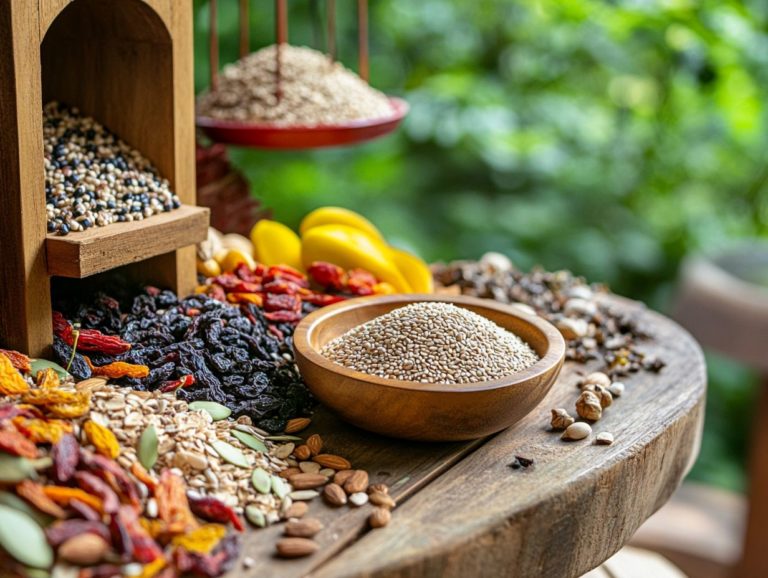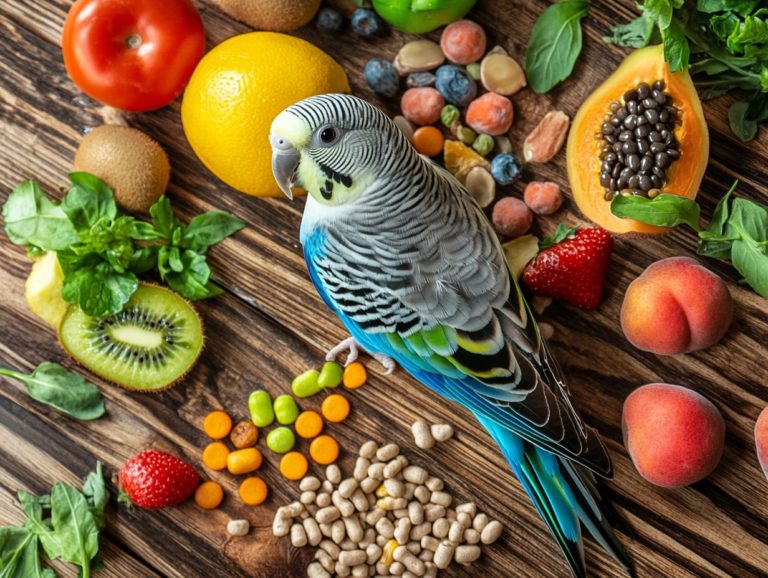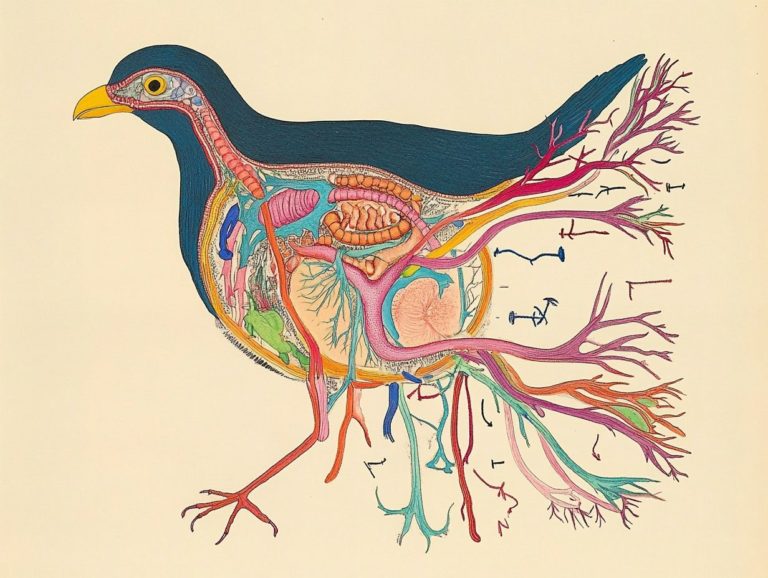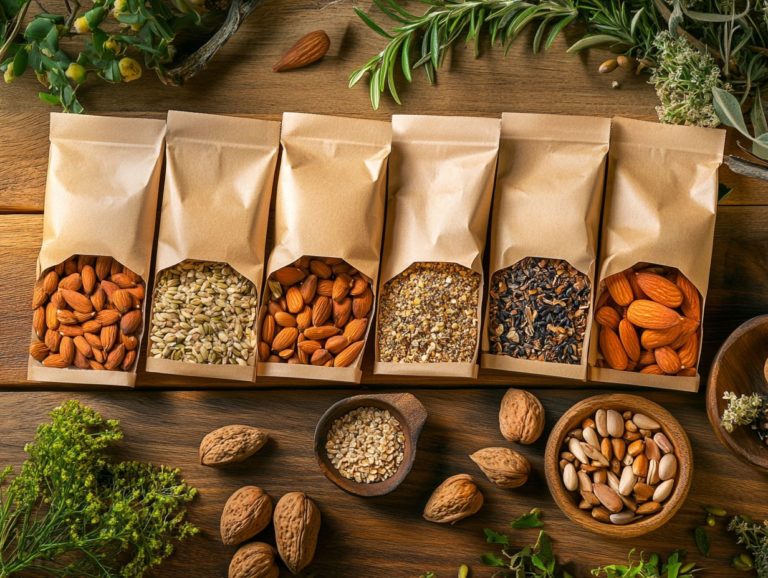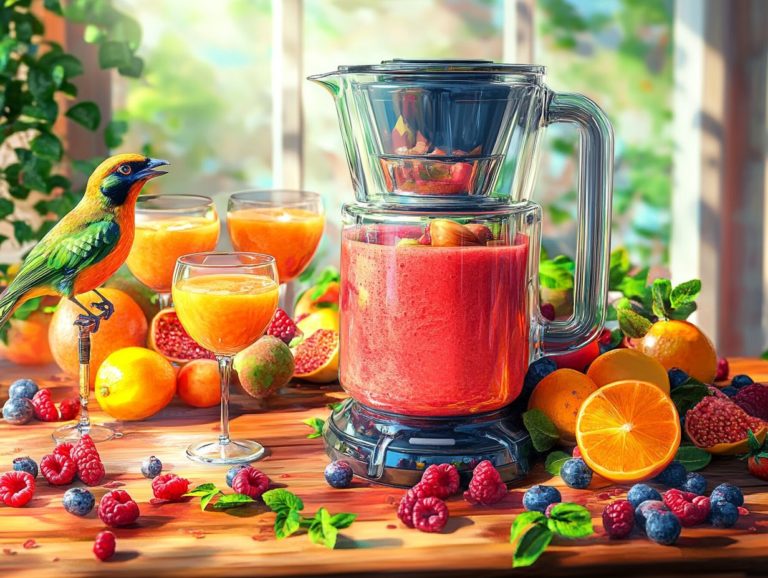5 Yummy Treats Birds Can’t Resist
Birds infuse joy and beauty into your backyard. What could be more enticing for them than delicious homemade treats? Get ready to become the ultimate bird-friendly host and watch your backyard come alive!
This guide presents five irresistible recipes that will attract a diverse array of feathered companions, from delightful bird seed cakes to refreshing fruity ice delights. You’ll discover the significance of providing these tasty offerings and learn which types of birds will love them.
We also offer tips on how to keep your avian visitors returning for more!
Contents
Key Takeaways:
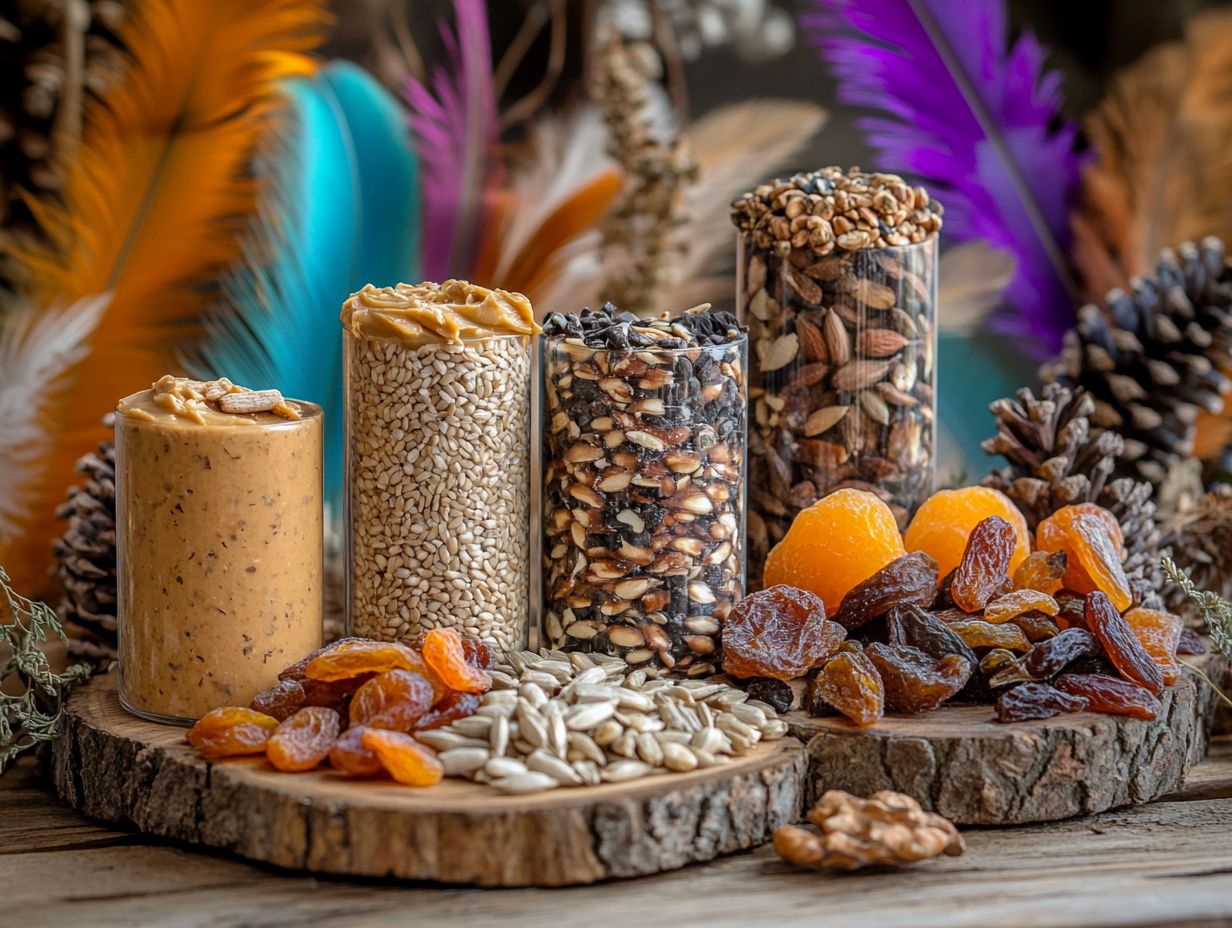
- Create delicious homemade bird seed cakes that birds will love!
- Make peanut butter pine cone feeders for a fun DIY project that provides high-energy snacks.
- Offer suet balls as a great source of fat and protein, especially in colder months.
1. Homemade Bird Seed Cakes
Homemade bird seed cakes are not just a treat; they re a delightful and nutritious way to meet the food needs of your birds. By offering a mix of seeds like sunflower, millet, and pumpkin seeds, you provide essential nutrients and energy that support their avian health.
These ingredients are a powerhouse of fiber and healthy fats, crucial for digestion and overall well-being. They keep your feathered friends active and playful. Sunflower seeds shine with their high vitamin E content, boosting a healthy immune system, while millet is an easily digestible grain that birds simply adore. Meanwhile, pumpkin seeds add extra nutrition, packed with magnesium and zinc to enhance muscle and feather health.
To prepare these treats, just mix the seeds with a binding agent, like coconut oil or bird-safe gelatin, which helps hold the mixture together. Pour the mixture into molds. Let your bird watch and even participate in the process; this fosters a strong bond as they anticipate this tasty reward.
2. Peanut Butter Pine Cone Feeders
Peanut butter pine cone feeders offer a delightful and engaging way to treat your avian friends to healthy snacks that cater to their preferences. This activity fosters a unique bond between you and your birds.
These charming feeders draw in a variety of feathered visitors, such as chickadees, nuthatches, and woodpeckers, adding vibrant touches to your outdoor space. The creamy texture and rich flavor of peanut butter provide an excellent source of healthy fats, delivering essential nutrients to support the birds’ energy needs, especially during chilly months.
However, keep safety in mind when using peanut butter. Since many individuals have peanut allergies, choose natural, unsweetened varieties that contain no added salt or sugar to ensure the snacks are both nutritious and safe for your feathered companions.
3. Suet Balls
Suet balls serve as an exceptional energy source for birds, providing a nourishing diet that enhances their health, especially during the colder months when natural food can be scarce.
These delightful, nutrient-rich offerings are typically made from animal fat, such as beef or mutton suet, and are often combined with seeds, nuts, and dried fruits. Their high-fat content delivers essential fatty acids, vital for sustaining energy levels in chilly weather.
The protein in peanut butter or seeds is crucial for muscle development and overall well-being. This makes suet balls irresistible to many birds, including woodpeckers, finches, and nuthatches, making them a beloved option for bird enthusiasts.
To maximize the benefits, provide these treats multiple times a week especially during peak feeding times to attract frequent visitors and support local bird populations.
Try these recipes today and bring joy to your backyard!
4. Fruity Ice Treats
Fruity ice treats made from fresh, frozen fruits like mango, pomegranate, and bananas offer a delightful and nutritious diet for your pet birds. These treats are packed with vitamins and minerals, including a nutrient that helps keep your bird healthy, which can significantly enhance avian health.
You can create a vibrant mix of berries think strawberries, blueberries, and raspberries. Each berry contributes its unique antioxidants, promoting overall well-being. These colorful combinations encourage hydration, especially during warmer months, and provide your birds with an engaging way to enjoy foraging.
By presenting these icy delights, you allow your feathered friends to tap into their natural instincts, exploring and savoring fresh food in a playful manner. Making fruity ice treats not only nourishes but also cultivates an enriching environment essential for keeping your avian companions happy and healthy.
5. Mealworm Delight
Mealworm delight is a protein-packed treat that your pet birds will adore. It s a perfect addition to a carefully curated diet that aligns with their food preferences and nutritional requirements.
These nutritious invertebrates bolster muscle development and feather growth while engaging your bird s natural foraging instincts, keeping them active and entertained. Offering mealworms as occasional treats can deepen your bond during feeding time, creating a rewarding experience for both you and your feathered companion.
Always handle mealworms with care to keep your feathered friend safe and happy! Ensure they are fresh and clean to prevent any risk of contamination. Be vigilant about any underlying health issues, such as digestive disorders, that could affect your bird’s ability to process this delicacy. Consulting with a veterinarian before introducing new foods can help maintain your bird s optimal health.
Why Is It Important to Provide Birds with Treats?
Providing your birds with treats goes beyond satisfying their cravings; it’s a vital component of pet care that nurtures better behavior, enhances your bond, and encourages healthy choices that align with their dietary needs and preferences.
Incorporating treats into training methods like clicker training and target training can enhance communication and cooperation. These techniques thrive on positive reinforcement, rewarding your bird with a treat for desired behaviors, making the learning experience enjoyable and effective.
Offering treats can act as a stress reliever; the anticipation of a reward often calms nerves and fosters a deeper level of trust. It s crucial to diversify the types of treats you provide, catering to individual preferences and nutritional needs. This enriches their diet and gives your birds something to look forward to during training sessions.
What Types of Birds Will Enjoy These Treats?
A variety of birds, such as parakeets, cockatiels, and budgies, appreciate a diverse selection of treats. This allows you to cater to their unique dietary needs and preferences, ensuring they enjoy a healthy diet.
For example, parakeets often have a fondness for seeds and fruits, while cockatiels may prefer leafy greens and small pellets. By offering a balanced assortment, you not only delight their taste buds but also significantly contribute to their overall well-being.
Incorporating treats like millet sprays or occasional slices of vegetables can elevate their happiness and mental stimulation, keeping them engaged and active. Customizing their diet with a mix of familiar and novel treats encourages exploration and playfulness, creating a joyful atmosphere for your feathered companions.
Try making these fruity ice treats today and watch your birds light up with joy!
Bird Treat Frequency: How Often?
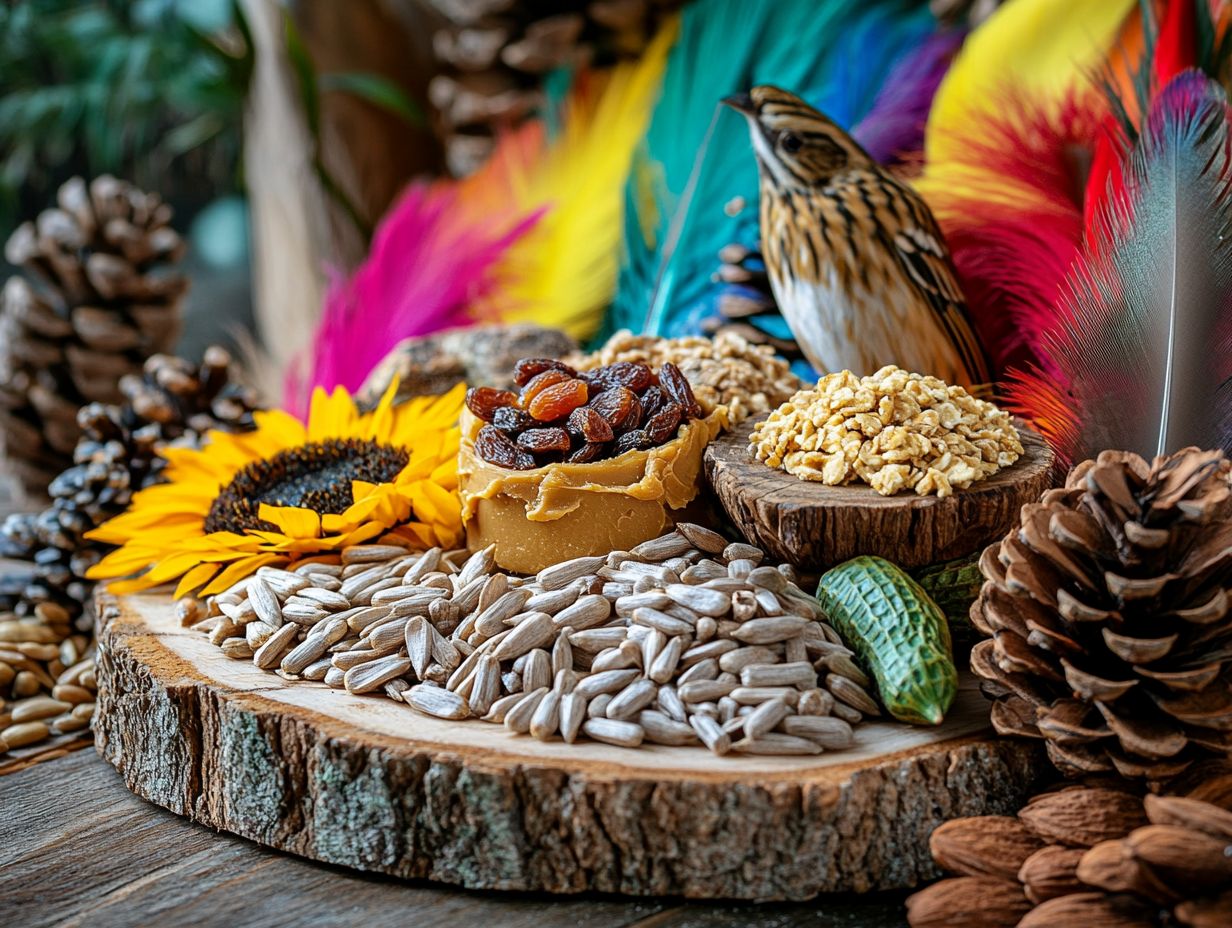
Determining how often you offer treats to your birds is crucial for their health. A balanced approach allows them to enjoy special snacks without undermining their diet.
Birds, like other pets, need a careful balance in their nutrition. Moderation is key when introducing treats into their routine. The frequency can vary significantly depending on the species. Smaller birds may benefit from fewer treats due to their faster metabolism, while larger species might enjoy them more regularly.
Overindulgence in treats can lead to obesity and other health issues, so careful portioning is vital. It’s essential to manage food preferences among different birds to prevent them from munching only on their favorite snacks, which can create nutritional imbalances.
Keep these guidelines in mind to create an exciting treat experience that promotes overall wellness for your feathered friends.
Why Choose Homemade Treats for Birds?
Homemade treats offer a wealth of benefits for your birds, providing superior nutritional value and allowing you to customize diets to meet specific needs. You can have peace of mind knowing their food is safe.
By choosing fresh ingredients, you can avoid unhealthy additives often found in commercial products. This approach supports their physical health and fosters a deeper emotional connection between you and your avian companions.
Experimenting with unique recipes adds richness to their diet and turns treat-making into a joyful bonding experience. Sharing the happiness of preparation enhances both the quality of their food and your interactions together.
Fun Treat Ideas for Birds
Exploring fun treat ideas can elevate your birds’ culinary experience with a delightful variety of avian treats and simple recipes tailored to their favorites.
Offer an array of options, including fresh fruits like berries and apples, along with savory bites made from raw vegetables such as carrots and bell peppers. Incorporating healthy fats like nuts and seeds provides essential nutrients while adding texture and flavor.
Create simple bird-friendly recipes, such as fruity skewers or veggie cups, to transform treat time into an engaging activity. These tasty, nutritious offerings inspire curiosity and playfulness, making mealtime an enriching experience.
Attracting More Birds with Treats
You can attract more birds to your yard through strategic feeding practices. Offer a delightful variety of healthy snacks and special treats that cater to different species’ unique food preferences.
Creating a bird-friendly oasis starts with selecting the right feeders. Incorporate platform, tube, or suet feeders to entice various birds. Fill these feeders with an assortment of seeds, nuts, and fruits. Sunflower seeds and peanuts are favorites, while hummingbirds flock to nectar-rich options.
Observe local bird behavior to fine-tune your offerings. If certain birds seem hesitant, they might prefer a different feeder or treat. Keeping the feeding area clean is essential; it encourages regular visits and fosters a nurturing environment for your feathered friends.
Frequently Asked Questions
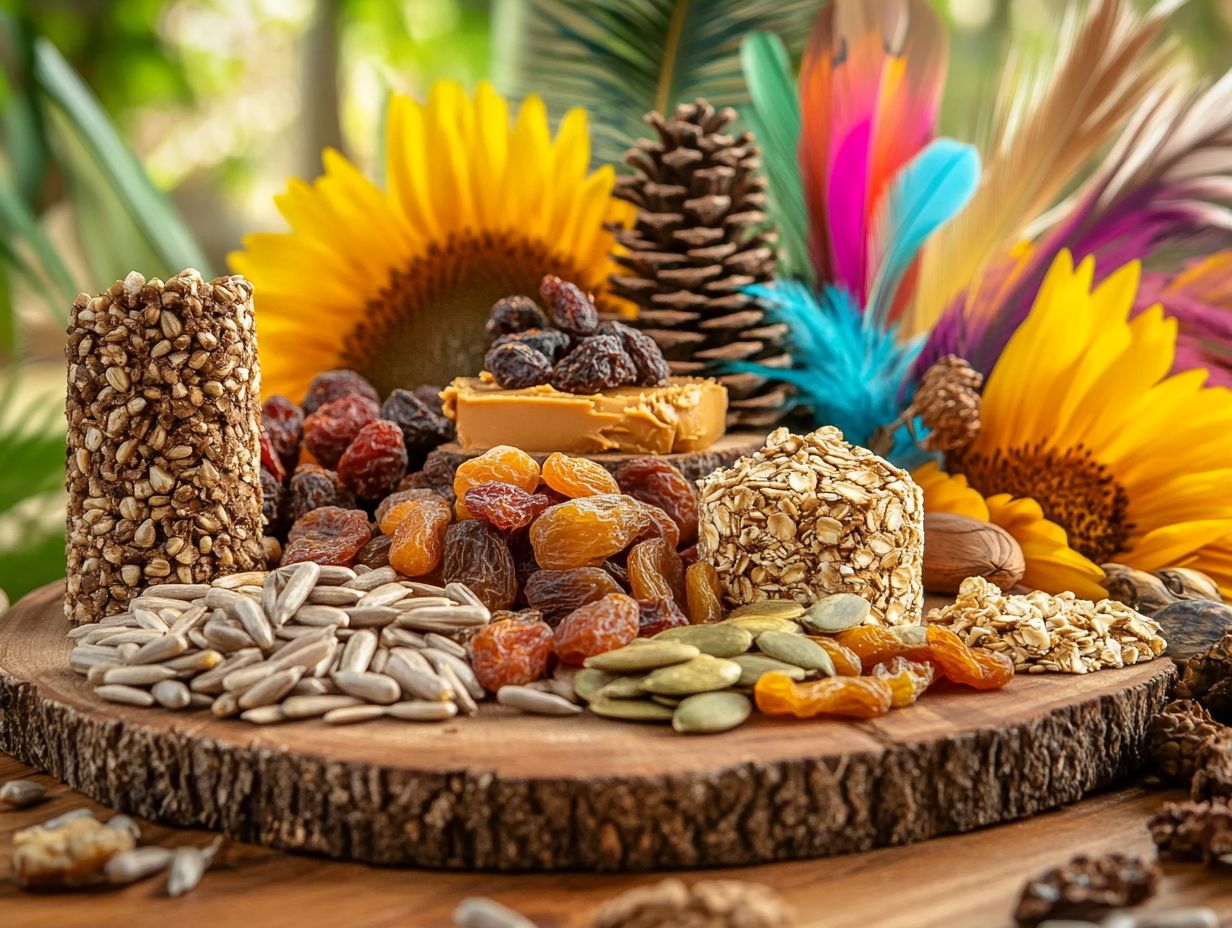
1. Can birds eat fruit as a treat?
Yes, birds can enjoy various fruits as a tasty treat. Popular options include apples, berries, and bananas.
2. What types of nuts are safe for birds to eat?
Birds can safely snack on unsalted and unsweetened nuts. Almonds, cashews, and peanuts are great choices.
Avoid giving them salted or flavored nuts.
3. Can birds eat cooked food as a treat?
Yes, some birds enjoy small amounts of cooked food. Just ensure the food is safe and free from harmful ingredients.
4. Are there any treats that should be avoided for birds?
Yes, certain treats should be avoided. These include chocolate, avocado, and caffeinated or alcoholic beverages.
5. Can I give my bird bread as a treat?
Birds may enjoy bread, but it shouldn’t be a staple in their diet. Bread lacks nutritional value and can cause health issues if given in large amounts.
6. What are some easy homemade treats for birds?
Get creative! You can whip up many fun and healthy homemade treats for your feathered friends. Consider offering chopped fruits, vegetables, cooked rice, or pasta.
Be sure to research which foods are safe for your specific type of bird.


